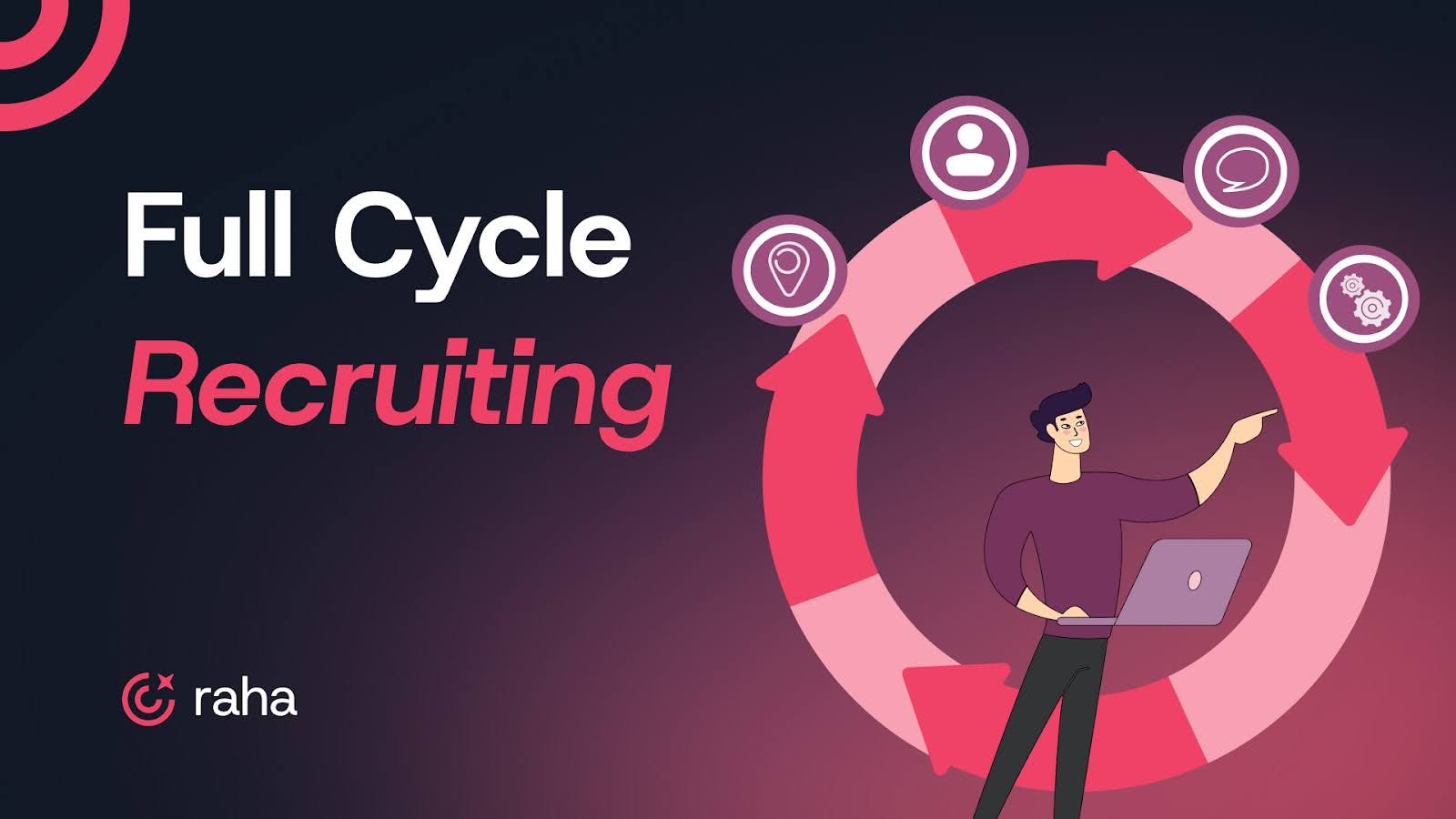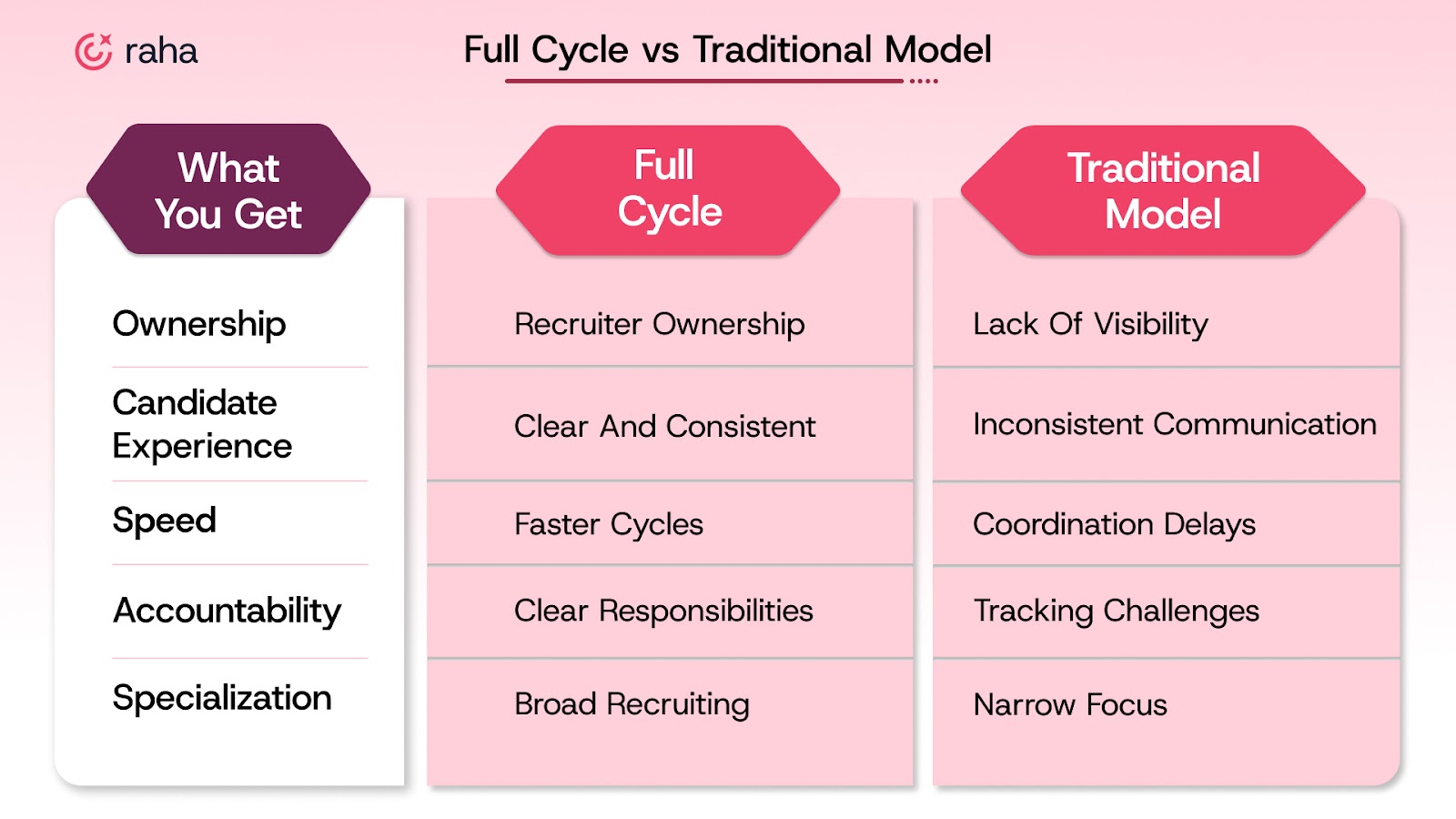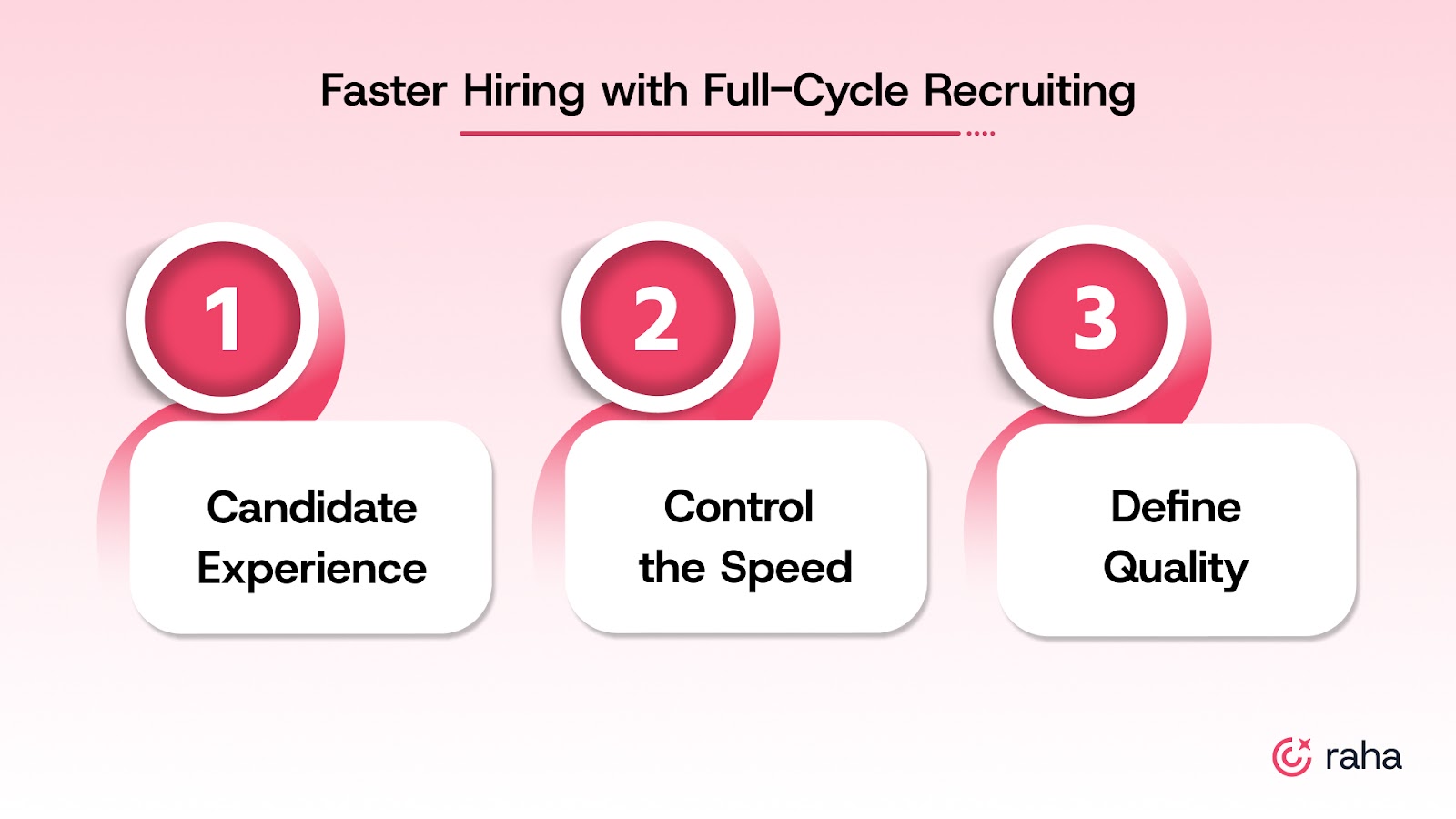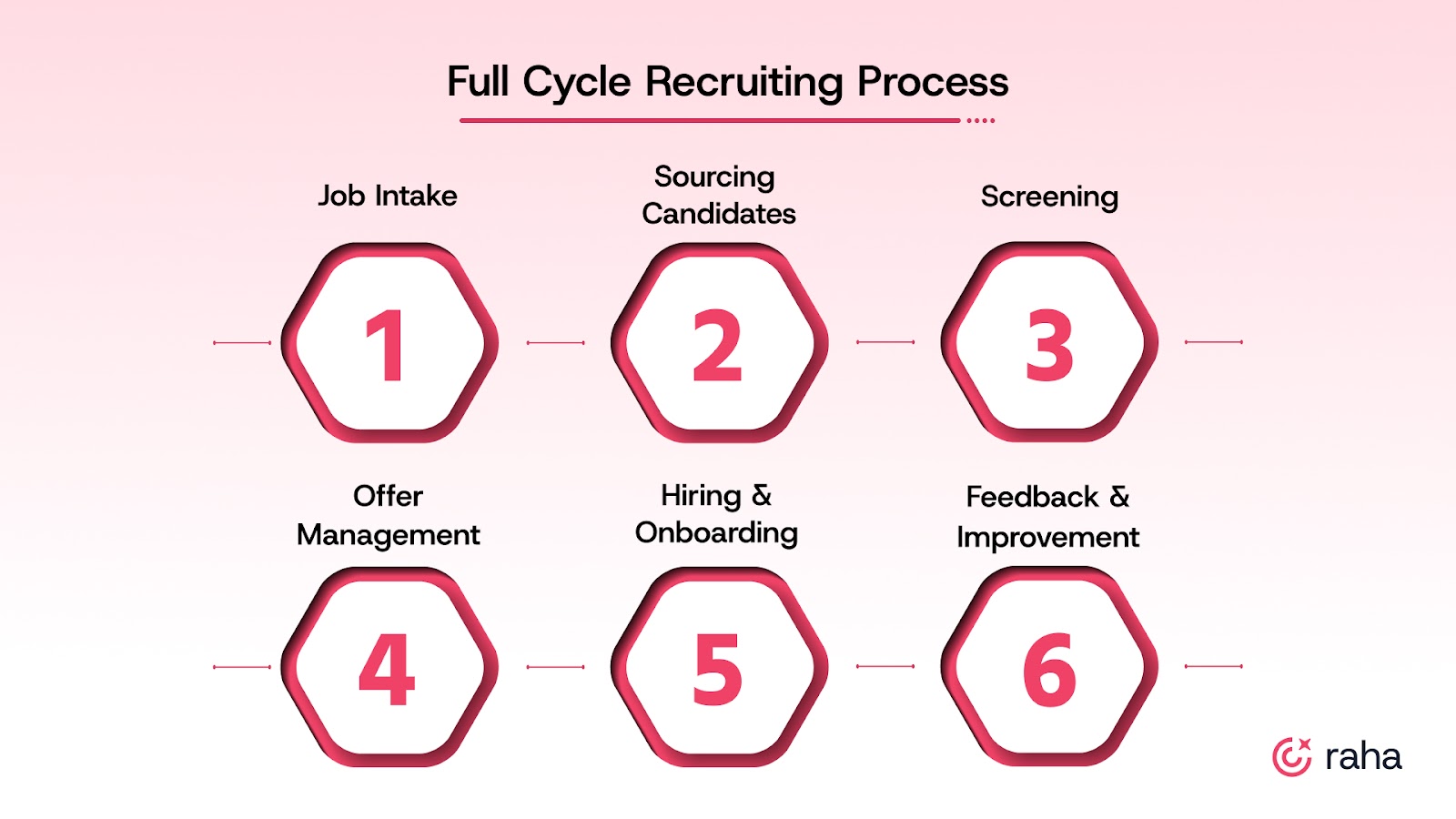
Did you know that 60% of candidates abandon applications due to delays or lack of follow-up. Slow hiring is costing you top talent. You hand off candidates from one department to another, they ghost you, and in the end, someone else swoops in and snags your best pick. What if you could cut all that out?
Enter full-cycle recruiting, a smarter, faster, and more personal approach where one recruiter owns the entire process from job posting to onboarding. It eliminates hand-offs, improves accountability, and delivers a consistent candidate experience.
In this blog, we'll break down what full-cycle recruiting is, how it compares to traditional models, and best practices to help you hire better and faster.
What Is Full Cycle Recruiting?

If you’re in a lean team, chances are you’re already doing full-cycle recruiting. You just haven’t labeled it that way. You write the JD, source, screen, run the loop, close, and move them into onboarding. There are no handoffs, no shared pipelines, just full ownership.
That kind of ownership gives you more speed and more control. You’re not waiting for feedback. You’re not losing candidates between touchpoints. And if a hire falls through, you know exactly where things went wrong because you were in it the whole way.
This model works best when:
- You’re covering more roles than you have team members for.
- Hiring managers want one clear point of contact.
- You care about the quality of hire and candidate experience.
While traditional recruiting can work well in large enterprises with highly specialized roles, full-cycle recruiting shines when speed, accountability, and candidate relationships are top priorities.
Also read: What is Recruitment Process Automation? Key Benefits, Use Cases & Tools
How Full-Cycle Recruiting Actually Speeds You Up

Traditional recruiting is slow. A lot of moving parts, too many hand-offs, and the risk of losing top candidates in the process. Full-cycle recruiting, on the other hand, puts you in charge from day one. This is how it works.
1. You Own the Candidate Experience
You’re not just the point of contact — you’re the constant. Candidates aren’t wondering who to follow up with or waiting days for feedback to trickle in. They trust the process more when they trust you. That keeps the momentum up and ghosting down.
What this looks like in practice:
You answer their questions right away. You clarify feedback without waiting for another team. You set the tone early and stay consistent until the offer's out.
2. You Control the Speed
With full-cycle recruiting, you have full control. You’re not waiting for approval from different departments. You make the calls, move fast, and fill the role quicker.
What this looks like in practice:
You spot strong fits early, push them forward fast, and don’t let scheduling bottlenecks kill momentum.
3. You Define Quality
No more mixed signals across stages. When you own the evaluation process, you define the bar. You make sure every candidate is measured against the same rubric, not gut feel or guesswork.
What this looks like in practice:
You know exactly why a candidate passed or didn’t. That’s how you improve the process, not just repeat it.

The 6 Steps of the Full Cycle Recruiting Process

If you’re still stuck with traditional recruiting, it’s time to reconsider. Full-cycle recruiting doesn’t just cut down on time; it maximizes the value of every candidate interaction. Here's how it actually moves the needle:
1. Job Intake That Sets You Up to Win
This isn’t just about collecting a job description. This is where you ask the questions no form ever will. Not just “What are the must-haves?” but “Why did the last person in this role leave?” and “What’s going to make or break this hire?”
When you’re running the full cycle, this step becomes your anchor. You’re not just sourcing to a spec. You’re building a hiring plan based on context that rarely makes it into writing.
How to do it right:
- Skip generic intake forms. Sit down with the hiring manager for 30 minutes.
- Clarify the business context, team dynamics, goals for the role, and what failure could look like.
- Don’t settle for vague answers. “Good communicator” usually means something specific—find out what that is.
What to track:
- Time from intake to role go-live
- Accuracy of job description vs. actual role needs (can be gauged by hiring manager feedback)
2. Sourcing That Fills Your Pipeline with the Right People
In full-cycle recruiting, sourcing is your job. That means job boards, referrals, inbound, outbound, and everything in between. You control the inputs, so you control the quality. No more waiting on handoffs or guessing what the hiring manager really meant.
You're closest to the role and the team. That puts you in the best position to recognize what “good” actually looks like and catch red flags early.
How to do it right:
- Start with outbound. Referrals and targeted outreach tend to convert better.
- Use AI tools or filters to surface patterns you might miss scanning manually.
- Run short-term tests on different sourcing channels. If something doesn’t work in two weeks, cut it or tweak the approach.
What to track:
- Number of qualified candidates per sourcing channel
- Diversity of the candidate pipeline
- Time-to-source first slate
3. Screening and Interviewing Without Wasted Rounds
This is where your judgment matters most. Screening and interviews are all about seeing beyond the resume and spotting potential others might miss.
How to do it right:
- Stick to a core evaluation rubric. Don’t reinvent the wheel for every role.
- Use one screening round to rule people out, not to gather maybe’s.
- Set a tight bar. If you’re not convinced in 30 minutes, they’re not the one.
What to track:
- Pass-through rate from screen to interview
- Time spent per resume
- Interview-to-offer ratio
4. Closing Candidates Like You Close Deals
You’ve made your pick, now it’s time to make the call. This part isn’t about HR process; it’s about timing, trust, and knowing how to read the room.
You need to build a relationship with this candidate. That gives you the leverage to close fast or the insight to know when they’re hesitating.
How to do it right:
- Align early with hiring managers on budget and flexibility.
- Know your candidate’s motivators before you hit the offer stage.
- Move quickly. Great candidates don’t wait.
What to track:
- Average time from first screen to final interview
- Panel feedback turnaround time
- Interview NPS (candidate and panelist)
Also read: The Role of AI in Recruitment: A Comprehensive Guide
5. Make Onboarding Part of the Plan
A great onboarding experience is what turns an accepted offer into a retained employee. You already know how easily momentum can drop between acceptance and day one.
Pre-boarding matters. So does having their first week mapped out. If the handoff is messy, they’ll start questioning their choice before they even log in.
How to do it right:
- Send a quick welcome message as soon as the offer is accepted.
- Loop in the hiring manager to make the new hire feel expected and wanted.
- Make sure IT, HR, and team leads are ready before day one hits.
What to track:
- Offer acceptance rate
- Time from the final round to the offer
- Drop-off rate at the offer stage
6. If You’re Not Reviewing the Process, You’re Repeating Mistakes
Once the role is filled, take a beat but look back.
What slowed you down? Where did candidates drop? What feedback did the hiring manager provide?
You’re running a process. That means you need data, and you need to use it.
How to do it right:
Review:
- Time-to-fill vs. time-to-accept
- Funnel drop-offs (by stage, not just totals)
- Feedback from candidates who passed and those who didn’t
What to track:
- New hire satisfaction at 30/60/90 days
- First-month attrition
- Post-hire recruiter QA notes on what worked or didn’t
But like any approach, full-cycle recruiting has its strengths and weaknesses. Let’s break down the pros and cons.

Full Cycle Recruiting: What Works and What May Break

Full cycle recruiting looks simple on the surface. One person owns everything from sourcing to offer-less handoff, more consistency, and a better candidate experience.
And when it’s done right, it works. It speeds up hiring, strengthens relationships with hiring managers, and fosters a clear sense of ownership throughout the entire funnel.
But getting it right takes more than assigning a recruiter to the full stack. Here’s what can go well, and what you should be cautious about.
The right setup makes full cycle recruiting work. But even the best recruiters can’t move fast if they’re stuck in manual workflows. 65% say those slow things down and hurt candidate experience.
That’s where tools like Raha AI come in.
See how Raha AI can help you speed up hiring without sacrificing quality.
How Raha AI Can Help
Raha AI was designed with full-cycle recruiters in mind. We automate 90% of interview management tasks, screen resumes 10x faster, and help teams close roles 15 days sooner.
Here’s what it handles
- Shortlists Without the Manual Scanning: Raha’s AI Resume Screener does the first pass for you. It parses resumes, matches them to your must-haves, and scores candidates based on fit, so you're not starting from a stack of 200 profiles.
- No More Back-and-Forth for Interviews: The AI Recruitment Coordinator syncs with your ATS, email, and calendar to handle scheduling start to finish. It finds time slots, sends invites, and manages follow-ups across time zones and panelists.
- Let the First Round Run Itself: The AI Interviewer runs structured, asynchronous interviews with questions you set or auto-generate. It evaluates responses and ranks candidates so your live calls start with pre-vetted talent.
- Easy to Plug In: Raha plugs right into the systems you already use. It’s designed to be recruiter-ready from day one, with no complicated onboarding, no delays.
- Fair Pricing That Scales: Raha complies with GDPR, SOC 2, and HIPAA standards. Pricing? The first 10 interviews are free. After that, it’s $1 per interview.
Ready to Make Full-Cycle Recruiting Work for You?
Full-cycle recruiting works. But it’s hard to run when you’re juggling 10 roles and 50 candidates.
Raha AI takes the load off. It handles resume screening, interview scheduling, and first-round calls, so you can move faster without burning out.
Want to scale full-cycle without the chaos? Let’s talk.
FAQ
Q1. What skills are required for a full-cycle recruiter?
A: Full-cycle recruiters must be skilled in sourcing, interviewing, negotiating, and onboarding. They must also have strong communication, organization, and problem-solving skills to manage the recruitment process end-to-end.
Q2. How can full-cycle recruiting be scaled in larger organizations?
A: In larger organizations, full-cycle recruiting can be scaled by implementing strong processes, utilizing technology, and potentially pairing recruiters with specialized support roles. Collaboration with hiring managers and regular process reviews helps ensure scalability.
Q3. What metrics should be tracked in full-cycle recruiting?
A: Key performance indicators (KPIs) to track include time-to-fill, offer acceptance rates, candidate satisfaction scores, and source quality. These metrics help measure the recruiting process's effectiveness and identify areas for improvement.
Q5. What is the role of hiring managers in full-cycle recruiting?
A: Hiring managers play a key role by collaborating with recruiters to define job requirements, candidate profiles, and expectations. They also participate in interviews and provide critical feedback, ensuring the hiring process aligns with the team's needs and culture.
Q5. How can full-cycle recruiting help improve retention?
A: By handling the hiring process, recruiters can ensure better cultural fit and smoother onboarding, increasing employee satisfaction and long-term retention. Engaged and well-integrated new hires are more likely to stay with the company.

